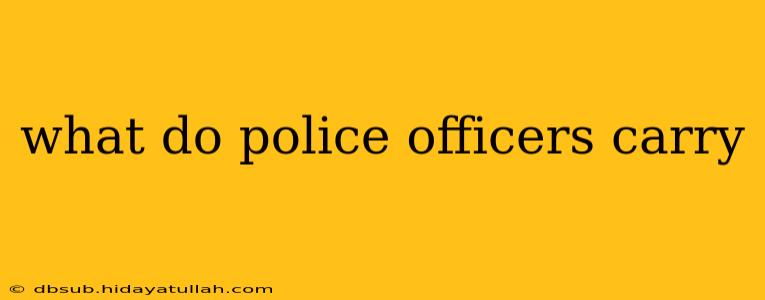Police officers carry a variety of equipment designed to keep them and the public safe. The specifics vary significantly depending on factors like the officer's role (patrol, SWAT, detective, etc.), department policies, and the specific threat environment. However, some common items are consistently found on officers' belts, in their vehicles, and in their personal protective equipment (PPE).
Essential Items Carried by Most Police Officers:
Weaponry:
- Firearm: This is the most crucial item. Handguns, typically semi-automatic pistols, are the standard sidearm. Some departments also issue rifles or shotguns, either carried openly or stored in patrol vehicles. The type and caliber of firearm varies by department and officer assignment.
- Less-Lethal Options: Officers also carry non-lethal weapons for situations where deadly force isn't justified. These can include tasers (stun guns), pepper spray (OC spray), and batons. The use of force continuum dictates when and how these tools are deployed.
Communication & Technology:
- Radio: Crucial for communication with dispatch, other officers, and supervisors. Radios allow officers to request backup, relay information, and coordinate responses to incidents.
- Body-worn Camera (BWC): Increasingly common, BWCs provide visual documentation of police interactions, enhancing accountability and transparency. They are vital in investigations and legal proceedings.
- Portable Computer or Mobile Device: Many officers carry devices allowing access to databases, crime reports, and other critical information in the field. This helps with identifying suspects, verifying information, and responding efficiently to calls.
Self-Defense & Protective Gear:
- Duty Belt: This is the foundation for carrying most equipment. It's a sturdy belt with various pouches and holders.
- Handcuffs: Used to restrain suspects during arrests. Officers are trained in proper handcuffing techniques to ensure safety and prevent injury.
- Pepper Spray: A non-lethal option to incapacitate aggressive individuals.
- Baton/Asp: A less-lethal defensive tool used for crowd control or subduing resisting suspects.
- Ballistic Vest: Often worn under the uniform, this provides critical protection against ballistic threats. The vest's level of protection can vary.
- First Aid Kit: A small kit for treating minor injuries, both to the officer and members of the public.
Items Carried Depending on Assignment or Situation:
- Patrol Rifle: Often carried in patrol vehicles, these are used for high-risk situations requiring greater firepower than a handgun.
- Tactical Gear: SWAT and specialized units carry more advanced weaponry and protective gear, including helmets, shields, and specialized breaching tools.
- Evidence Bags: Used to collect and preserve evidence at crime scenes.
- Notepad & Pen: Essential for taking notes, documenting observations, and recording details of incidents.
- Flashlight: Provides illumination in low-light conditions.
The Importance of Training and Proper Use of Equipment:
It's crucial to remember that police officers undergo extensive training on the proper use and handling of all their equipment. This training emphasizes safety, de-escalation techniques, and legal guidelines to ensure responsible and effective law enforcement. The use of force continuum guides officers in making decisions about which tools to deploy in specific circumstances.
This overview provides a general understanding of the equipment commonly carried by police officers. Remember that the specifics can vary greatly, and the ultimate goal of this equipment is to protect both the officers and the public they serve.
